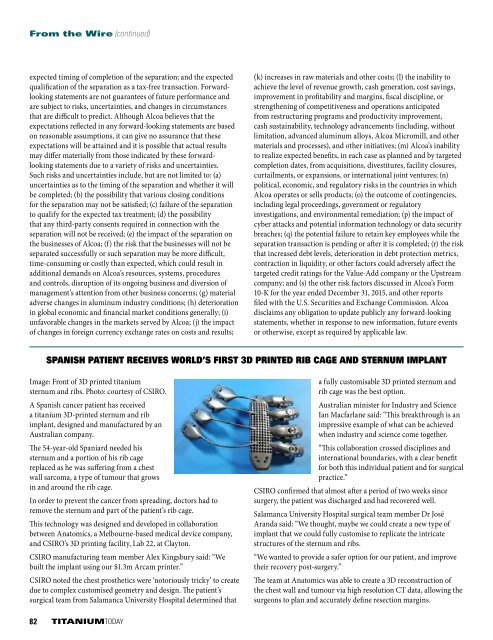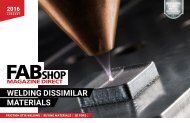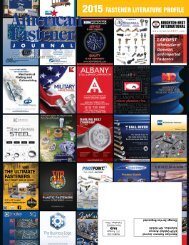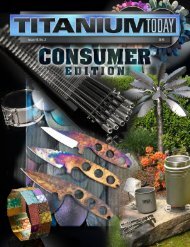100% Positive Material Identification
23mhiW2
23mhiW2
Create successful ePaper yourself
Turn your PDF publications into a flip-book with our unique Google optimized e-Paper software.
From the Wire (continued)<br />
expected timing of completion of the separation; and the expected<br />
qualification of the separation as a tax-free transaction. Forwardlooking<br />
statements are not guarantees of future performance and<br />
are subject to risks, uncertainties, and changes in circumstances<br />
that are difficult to predict. Although Alcoa believes that the<br />
expectations reflected in any forward-looking statements are based<br />
on reasonable assumptions, it can give no assurance that these<br />
expectations will be attained and it is possible that actual results<br />
may differ materially from those indicated by these forwardlooking<br />
statements due to a variety of risks and uncertainties.<br />
Such risks and uncertainties include, but are not limited to: (a)<br />
uncertainties as to the timing of the separation and whether it will<br />
be completed; (b) the possibility that various closing conditions<br />
for the separation may not be satisfied; (c) failure of the separation<br />
to qualify for the expected tax treatment; (d) the possibility<br />
that any third-party consents required in connection with the<br />
separation will not be received; (e) the impact of the separation on<br />
the businesses of Alcoa; (f) the risk that the businesses will not be<br />
separated successfully or such separation may be more difficult,<br />
time-consuming or costly than expected, which could result in<br />
additional demands on Alcoa’s resources, systems, procedures<br />
and controls, disruption of its ongoing business and diversion of<br />
management’s attention from other business concerns; (g) material<br />
adverse changes in aluminum industry conditions; (h) deterioration<br />
in global economic and financial market conditions generally; (i)<br />
unfavorable changes in the markets served by Alcoa; (j) the impact<br />
of changes in foreign currency exchange rates on costs and results;<br />
(k) increases in raw materials and other costs; (l) the inability to<br />
achieve the level of revenue growth, cash generation, cost savings,<br />
improvement in profitability and margins, fiscal discipline, or<br />
strengthening of competitiveness and operations anticipated<br />
from restructuring programs and productivity improvement,<br />
cash sustainability, technology advancements (including, without<br />
limitation, advanced aluminum alloys, Alcoa Micromill, and other<br />
materials and processes), and other initiatives; (m) Alcoa’s inability<br />
to realize expected benefits, in each case as planned and by targeted<br />
completion dates, from acquisitions, divestitures, facility closures,<br />
curtailments, or expansions, or international joint ventures; (n)<br />
political, economic, and regulatory risks in the countries in which<br />
Alcoa operates or sells products; (o) the outcome of contingencies,<br />
including legal proceedings, government or regulatory<br />
investigations, and environmental remediation; (p) the impact of<br />
cyber attacks and potential information technology or data security<br />
breaches; (q) the potential failure to retain key employees while the<br />
separation transaction is pending or after it is completed; (r) the risk<br />
that increased debt levels, deterioration in debt protection metrics,<br />
contraction in liquidity, or other factors could adversely affect the<br />
targeted credit ratings for the Value-Add company or the Upstream<br />
company; and (s) the other risk factors discussed in Alcoa’s Form<br />
10-K for the year ended December 31, 2015, and other reports<br />
filed with the U.S. Securities and Exchange Commission. Alcoa<br />
disclaims any obligation to update publicly any forward-looking<br />
statements, whether in response to new information, future events<br />
or otherwise, except as required by applicable law.<br />
SPANISH PATIENT RECEIVES WORLD’S FIRST 3D PRINTED RIB CAGE AND STERNUM IMPLANT<br />
Image: Front of 3D printed titanium<br />
sternum and ribs. Photo: courtesy of CSIRO.<br />
A Spanish cancer patient has received<br />
a titanium 3D-printed sternum and rib<br />
implant, designed and manufactured by an<br />
Australian company.<br />
The 54-year-old Spaniard needed his<br />
sternum and a portion of his rib cage<br />
replaced as he was suffering from a chest<br />
wall sarcoma, a type of tumour that grows<br />
in and around the rib cage.<br />
In order to prevent the cancer from spreading, doctors had to<br />
remove the sternum and part of the patient’s rib cage.<br />
This technology was designed and developed in collaboration<br />
between Anatomics, a Melbourne-based medical device company,<br />
and CSIRO’s 3D printing facility, Lab 22, at Clayton.<br />
CSIRO manufacturing team member Alex Kingsbury said: “We<br />
built the implant using our $1.3m Arcam printer.”<br />
CSIRO noted the chest prosthetics were ‘notoriously tricky’ to create<br />
due to complex customised geometry and design. The patient’s<br />
surgical team from Salamanca University Hospital determined that<br />
a fully customisable 3D printed sternum and<br />
rib cage was the best option.<br />
Australian minister for Industry and Science<br />
Ian Macfarlane said: “This breakthrough is an<br />
impressive example of what can be achieved<br />
when industry and science come together.<br />
“This collaboration crossed disciplines and<br />
international boundaries, with a clear benefit<br />
for both this individual patient and for surgical<br />
practice.”<br />
CSIRO confirmed that almost after a period of two weeks since<br />
surgery, the patient was discharged and had recovered well.<br />
Salamanca University Hospital surgical team member Dr José<br />
Aranda said: “We thought, maybe we could create a new type of<br />
implant that we could fully customise to replicate the intricate<br />
structures of the sternum and ribs.<br />
“We wanted to provide a safer option for our patient, and improve<br />
their recovery post-surgery.”<br />
The team at Anatomics was able to create a 3D reconstruction of<br />
the chest wall and tumour via high resolution CT data, allowing the<br />
surgeons to plan and accurately define resection margins.<br />
82 TITANIUMTODAY







